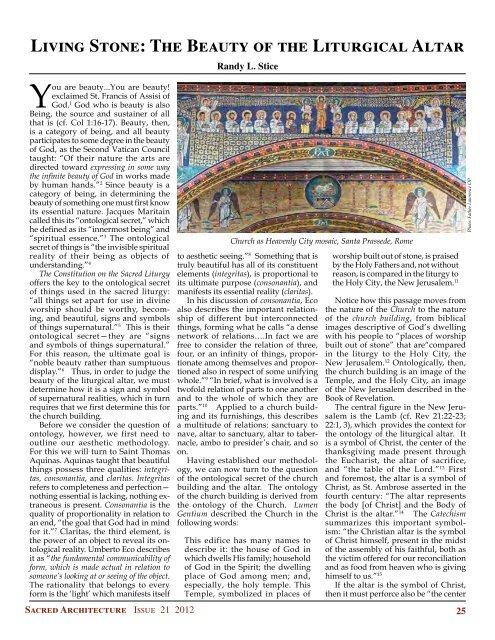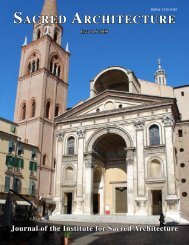ArticlesThomas Aquinas College Chapel byDuncan Stroikprofession still sees clients spendingmoney badly by hiring architects withlittle to no education in the principlesand requirements of canonical classicaldesign. And so their buildings becomeinarticulate and illiterate exampleswhich not only discredit the CatholicChurch as patron of the arts, but giveammunition to the opponents of NewClassicism who desire to characterizetraditional architecture as cartoonishand backward-looking. 18 When onedesires to preach to the world by use ofthe eloquent language of architecture,there is no excuse <strong>for</strong> the architecturalequivalent of bad grammar and typos,especially when the architectural professionis now rich with competent andtalented poets of architectural <strong>for</strong>m.While on the one hand it is encouragingto see clients looking <strong>for</strong> traditionalarchitecture even on the local level, thisinspired intuition would be well servedby a quest <strong>for</strong> architectural excellence.Its trials notwithstanding, it is fairto say that New Classical architecturehas not suffered the fate of academia’spostmodernism. In retrospect, postmodernismseems to have consisted, inpart, of reactionary moves founded onsomewhat shallow philosophical underpinningsunlikely to provide deepintellectual satisfaction except amongPhoto: schafphoto.comrelativist historians convinced of theprinciples of Hegelian determinism.Though it found some initial nourishmentin post-modern academia, NewClassicism has in many ways beensupported by numerous grass rootsmovements, whether the readers ofAdoremus Bulletin or the concernedbishops, priests, and lay people whoread, attend conferences, visit churchesand pray, getting ever more groundedin an authentic understanding ofthe documents of the Second VaticanCouncil and the strong theological andaesthetic leadership of Pope BenedictXVI. Practitioners of New Classicismstill face obstacles from pragmatists,ideologically-driven liturgical professionals,misperceptions about the costsand practicalities of traditional architecture,and the continued resistanceof professional societies in architectureand liturgy. But the momentumtoward a theologically-in<strong>for</strong>med reengagementwith the Church’s greatarchitectural and liturgical traditionsis not waning, but growing. And althoughevery movement must be waryof the “change beyond the change,”even an objective observer can <strong>for</strong>eseein the year 2012–in a way that could notbe seen in 2001–that a more profoundunderstanding of both the Council’sdocuments and church architecture iscurrently at play, with even the hint ofglory beyond the horizon.Dr. Denis R. McNamara is an architecturalhistorian who teaches at the Liturgical<strong>Institute</strong> at Mundelein Seminary. He haswritten extensively on sacred architecture,including his recent book How toRead Churches: A Crash Course inEcclesiastical <strong>Architecture</strong>.(Endnotes)1. This conference, organized by Liturgical <strong>Institute</strong> directorMonsignor M. Francis Mannion and Denis McNamara, includedkeynote speaker Father Robert Barron, as well as architectPaige Cowley, Father Brian Hughes, Yale Divinity Schoolprofessor Father Jaime Lara, architects James McCrery andDuncan Stroik, and University of Virginia professor of Easternreligious art, John Yiannias. <strong>The</strong> title of the conference was aplay on the “Church <strong>for</strong> 2000,” an international competition <strong>for</strong>a new Jubilee church in Rome sponsored by the Archdiocese ofRome. Its finalists included the winner, Neo-modernist RichardMeier and Deconstructivist Frank Gehry among other leadingsecular modernist architects. <strong>The</strong> Liturgical <strong>Institute</strong> sponsoredsubsequent conferences on church architecture in 2002, 2003,2006, and 2010.2. See Reconquering <strong>Sacred</strong> Space: Rediscovering Tradition inTwentieth Century Liturgical <strong>Architecture</strong> (Rome: Il Bosco e laNave, 1999) and Reconquering <strong>Sacred</strong> Space 2000: <strong>The</strong> Church in theCity of the Third Millennium (Rome: Il Bosco e la Nave, 2000).3. Notable examples of early coverage of the renewal of churcharchitecture include: an entire issue dedicated to architecturein the May-June, 1997 issue of Catholic Dossier and the July 2002issue of <strong>The</strong> Priest. Ann Carey’s article “Ever Ancient, Ever New”appeared in the journal Sursum Corda in the issue of Summer,1998 and Thomas Gordon Smith’s article, entitled “Reconnectingto Tradition,” appeared in the same journal in the Fall, 1998issue. Other articles appeared regularly in <strong>Sacred</strong> <strong>Architecture</strong> andAdoremus Bulletin.4. One exception to this statement was architect John Bartlett’sdesign <strong>for</strong> rebuilding the parish church of San Juan Capistranonear the famous mission in Cali<strong>for</strong>nia. <strong>The</strong> new building, whichopened in 1986, was built along the lines of traditional MissionStyle architecture with the help of Dr. Norman Neuerberg, whohad earlier provided archaeological expertise <strong>for</strong> the new J. PaulGetty Museum in Malibu Cali<strong>for</strong>nia, a building meant to displayancient art and modeled on an ancient Roman villa. Whileindeed this church was completed and being used, it was mostlikely seen as closely related to an archaeological endeavor andwas not highly influential in the liturgical-architectural climateof the time. For more in<strong>for</strong>mation on this project, see PatrickJames Riley, “<strong>The</strong> New Church of San Juan Capistrano,” <strong>Sacred</strong><strong>Architecture</strong> 4 (Fall 2000): 19-21.5. Although the General Instruction of the Roman Missal bynature gives only the broadest laws <strong>for</strong> church design, one majorchange in the new text gave first option to the placement of thetabernacle in the church sanctuary rather than a separate chapeland specifically mentioned the preservation of older altars “nolonger used <strong>for</strong> celebration” (par. 315, section a).6. Patricia Leigh Brown, “<strong>Architecture</strong>’s Young Old Fogeys,”New York Times (Feb 9, 1995). <strong>The</strong> architect quoted was JamesStewart Polshek, <strong>for</strong>mer Dean of the architecture school atColumbia University, and at the time of this writing in 2012, stillone of the leading modernist architecture practitioners in theUnited States.7. For more on the proposed Raleigh cathedral commission, seeNC Catholics (September 2011): 20-23, 34. <strong>The</strong> architect <strong>for</strong> theproposed 2000 seat Cathedral of the Holy Name of Jesus is JamesMcCrery of McCrery Architects in Washington, DC.8. William Busch, “Secularism in Church <strong>Architecture</strong>,” ChurchProperty Administration 19 (November-December 1955): 33.9. For some of the early polemic about the appearance ofmodernism in church architecture see “<strong>The</strong> Church Functional,”Time 39 (23 March 1942): 52; Joseph Hudnut, “Picture,Sentiment and Symbol,” Architectural Record 96 (September1944): 84; William Heyl Thompson, “Concrete <strong>for</strong> Ecclesiastical<strong>Architecture</strong>,” Architectural Concrete 2 (1936): 21; John F. Ryan.“Modernism Goes to Church,” American Architect 138 (November1930): 50-53, 86; Joseph Hudnut, “<strong>The</strong> Modern Spirit EntersContemporary Church <strong>Architecture</strong>,” American Architect 142(December 1932): 12. For a sample of two late traditionalchurches see “<strong>The</strong> Church of Our Lady of Victory,” ChurchProperty Administration 12 (January-February, 1948): 22-23, 66-67and “Traditional Gothic Blends with Modern,” Church PropertyAdministration 17 (January-February 1953): 32-35.10. It is interesting to note that the a<strong>for</strong>ementioned architectEdward Schulte wrote in an unpublished paper read be<strong>for</strong>e theCincinnati Literary Club entitled “Quotations” from 1968: “<strong>The</strong>man who said that ‘less is more’ is also saying that nothing is themost.” Cincinnati Historical Society Archives, Edward Schultepapers.11. Richard John, Thomas Gordon Smith: <strong>The</strong> Rebirth of Classical<strong>Architecture</strong> (London: Andreas Papadakis, 2001), 45. For more onThomas Gordon Smith’s biography and work at the Our Ladyof Guadalupe seminary in Nebraska, see Denis McNamara, “‘Lively Mental Energy:’ Thomas Gordon Smith and the Our Ladyof Guadalupe Seminary,” <strong>Sacred</strong> <strong>Architecture</strong> 18 (Fall 2010).12. George L. Hersey, “Allan Greenberg and the ClassicalGame,” Architectural Record 173 (October 1985): 160-61 andHersey, <strong>The</strong> Lost Meaning of Classical <strong>Architecture</strong> (New Haven:Yale university Press, 1988).13. “What Is the Society <strong>for</strong> Catholic Liturgy?,” Antiphon 1(Spring 1996): 12-13.14. M. Francis Mannion, “Toward a New Era in Liturgical<strong>Architecture</strong>,” Studia Anselmiana 131 (2001): 45-76.15. Several of the Liturgical <strong>Institute</strong>’s graduates havepenned architectural guidelines in their roles as directors oftheir diocesan office of worship. See also Denis McNamara,Catholic Church <strong>Architecture</strong> and the Spirit of the Liturgy (Chicago:Hillenbrand Books, 2009).16. Michael E. De Sanctis, “Notre Dame’s Neo-Classicists Yearnto Build Grand Old Churches,” National Catholic Reporter 36(April 21, 2000): 12.17. George Knight, “Style As Substance: What Does the ThomasAquinas Chapel Mean?,” Faith and Form 2 (2010): 6-11.18. One recently built seminary chapel in the Northeast,<strong>for</strong> example, began its design by consulting a company thatproduces beams <strong>for</strong> log cabins, and produced an octagonalchapel which fails in nearly every attempt to produce credibletraditional detailing, window placement, and liturgicalfurnishings.24 <strong>Sacred</strong> <strong>Architecture</strong> <strong>Issue</strong> 21 2012
Living Stone: <strong>The</strong> Beauty of the Liturgical AltarYou are beauty...You are beauty!exclaimed St. Francis of Assisi ofGod. 1 God who is beauty is alsoBeing, the source and sustainer of allthat is (cf. Col 1:16-17). Beauty, then,is a category of being, and all beautyparticipates to some degree in the beautyof God, as the Second Vatican Counciltaught: “Of their nature the arts aredirected toward expressing in some waythe infinite beauty of God in works madeby human hands.” 2 Since beauty is acategory of being, in determining thebeauty of something one must first knowits essential nature. Jacques Maritaincalled this its “ontological secret,” whichhe defined as its “innermost being” and“spiritual essence.” 3 <strong>The</strong> ontologicalsecret of things is “the invisible spiritualreality of their being as objects ofunderstanding.” 4<strong>The</strong> Constitution on the <strong>Sacred</strong> Liturgyoffers the key to the ontological secretof things used in the sacred liturgy:“all things set apart <strong>for</strong> use in divineworship should be worthy, becoming,and beautiful, signs and symbolsof things supernatural.” 5 This is theirontological secret—they are “signsand symbols of things supernatural.”For this reason, the ultimate goal is“noble beauty rather than sumptuousdisplay.” 6 Thus, in order to judge thebeauty of the liturgical altar, we mustdetermine how it is a sign and symbolof supernatural realities, which in turnrequires that we first determine this <strong>for</strong>the church building.Be<strong>for</strong>e we consider the question ofontology, however, we first need tooutline our aesthetic methodology.For this we will turn to Saint ThomasAquinas. Aquinas taught that beautifulthings possess three qualities: integritas,consonantia, and claritas. Integritasrefers to completeness and perfection—nothing essential is lacking, nothing extraneousis present. Consonantia is thequality of proportionality in relation toan end, “the goal that God had in mind<strong>for</strong> it.” 7 Claritas, the third element, isthe power of an object to reveal its ontologicalreality. Umberto Eco describesit as “the fundamental communicability of<strong>for</strong>m, which is made actual in relation tosomeone’s looking at or seeing of the object.<strong>The</strong> rationality that belongs to every<strong>for</strong>m is the ‘light’ which manifests itself<strong>Sacred</strong> <strong>Architecture</strong> <strong>Issue</strong> 21 2012Randy L. SticeChurch as Heavenly City mosaic, Santa Prassede, Rometo aesthetic seeing.” 8 Something that istruly beautiful has all of its constituentelements (integritas), is proportional toits ultimate purpose (consonantia), andmanifests its essential reality (claritas).In his discussion of consonantia, Ecoalso describes the important relationshipof different but interconnectedthings, <strong>for</strong>ming what he calls “a densenetwork of relations….In fact we arefree to consider the relation of three,four, or an infinity of things, proportionateamong themselves and proportionedalso in respect of some unifyingwhole.” 9 “In brief, what is involved is atwofold relation of parts to one anotherand to the whole of which they areparts.” 10 Applied to a church buildingand its furnishings, this describesa multitude of relations: sanctuary tonave, altar to sanctuary, altar to tabernacle,ambo to presider’s chair, and soon.Having established our methodology,we can now turn to the questionof the ontological secret of the churchbuilding and the altar. <strong>The</strong> ontologyof the church building is derived fromthe ontology of the Church. LumenGentium described the Church in thefollowing words:This edifice has many names todescribe it: the house of God inwhich dwells His family; householdof God in the Spirit; the dwellingplace of God among men; and,especially, the holy temple. ThisTemple, symbolized in places ofworship built out of stone, is praisedby the Holy Fathers and, not withoutreason, is compared in the liturgy tothe Holy City, the New Jerusalem. 11Notice how this passage moves fromthe nature of the Church to the natureof the church building, from biblicalimages descriptive of God’s dwellingwith his people to “places of worshipbuilt out of stone” that are“comparedin the liturgy to the Holy City, theNew Jerusalem. 12 Ontologically, then,the church building is an image of theTemple, and the Holy City, an imageof the New Jerusalem described in theBook of Revelation.<strong>The</strong> central figure in the New Jerusalemis the Lamb (cf. Rev 21:22-23;22:1, 3), which provides the context <strong>for</strong>the ontology of the liturgical altar. Itis a symbol of Christ, the center of thethanksgiving made present throughthe Eucharist, the altar of sacrifice,and “the table of the Lord.” 13 Firstand <strong>for</strong>emost, the altar is a symbol ofChrist, as St. Ambrose asserted in thefourth century: “<strong>The</strong> altar representsthe body [of Christ] and the Body ofChrist is the altar.” 14 <strong>The</strong> Catechismsummarizes this important symbolism:“the Christian altar is the symbolof Christ himself, present in the midstof the assembly of his faithful, both asthe victim offered <strong>for</strong> our reconciliationand as food from heaven who is givinghimself to us.” 15If the altar is the symbol of Christ,then it must per<strong>for</strong>ce also be “the center25Photo: Father Lawrence OP










